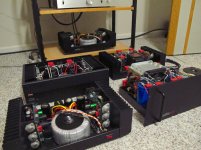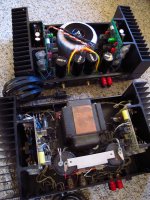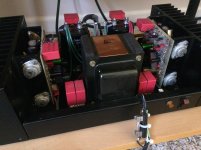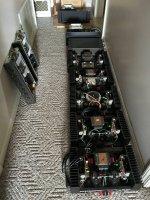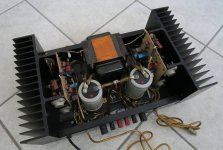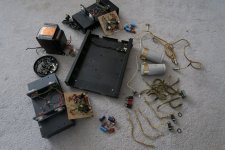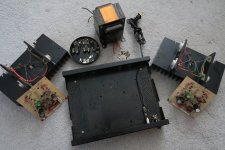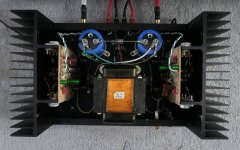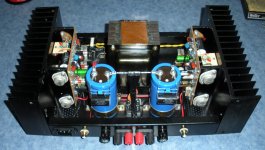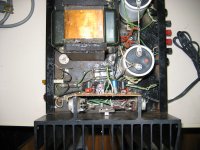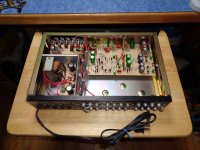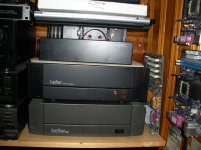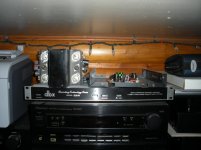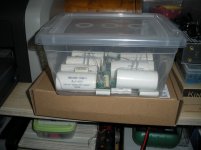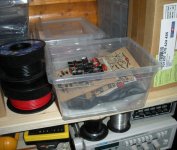It probably does. I think Erno has consulted for this company previously. Maybe still does ...
mlloyd1
mlloyd1
Runner(s) up...
Of all of the choices, the MC-220 Musical Concepts PA4 boards [and honorable mention, MM200 Franken'amp with PC19c] driving the Maggies, produce such intense room compression, with an immense and coherent sound field, also 'seem to have unlimited power' (a sort of conundrum, to me). I have had concerns of equipment and hearing damage 😉 I can play this system far louder, than "practical listening" or that I would have imagined, ever dreamt of... I do power listening; in or for short periods;
Typically with most 'smaller amps' (for me) it often causes me 'nervous listening' worrying about drive levels... The 'optimized' Hafler DH200/220 based amps are amazing, challenge many other designs, each with their own merits... personalities. Most of my work / interests have been on power supply work, not trying to re-think circuit design or rebuild exemplary engineering.
The 6 MOSFET output versions in front, while they are amazing, they are in some ways challenged by the 4 output versions, power aside. The "Hafler 500" having ~15 volts more on the circuit, adds to the amps tonal weight and sense of authority, which the front left P230, (6) output version of a 220 does not mirror, *but it has a likeness... especially on the 'big' MG-3.5R panels.
Each are winners in their own right... Honorable mention to the heavily torqued Adcom 545II, gotta have a bi-polar design in the mix...
Of all of the choices, the MC-220 Musical Concepts PA4 boards [and honorable mention, MM200 Franken'amp with PC19c] driving the Maggies, produce such intense room compression, with an immense and coherent sound field, also 'seem to have unlimited power' (a sort of conundrum, to me). I have had concerns of equipment and hearing damage 😉 I can play this system far louder, than "practical listening" or that I would have imagined, ever dreamt of... I do power listening; in or for short periods;
Typically with most 'smaller amps' (for me) it often causes me 'nervous listening' worrying about drive levels... The 'optimized' Hafler DH200/220 based amps are amazing, challenge many other designs, each with their own merits... personalities. Most of my work / interests have been on power supply work, not trying to re-think circuit design or rebuild exemplary engineering.
The 6 MOSFET output versions in front, while they are amazing, they are in some ways challenged by the 4 output versions, power aside. The "Hafler 500" having ~15 volts more on the circuit, adds to the amps tonal weight and sense of authority, which the front left P230, (6) output version of a 220 does not mirror, *but it has a likeness... especially on the 'big' MG-3.5R panels.
Each are winners in their own right... Honorable mention to the heavily torqued Adcom 545II, gotta have a bi-polar design in the mix...
Attachments
One of my next projects...
actually one of several. projects. (a good thing, not a complaint)
P230 with balanced inputs, such a gawd awful front end / interface musically, it's ~ ALL GOTTA GO ~ The front end music homogenizer... cringe. It is apparent how they beefed up the front end AC power and over temp sensor circuit (I rip all of that out anyway) but nice to see they finally figured some basics out this far in the game.
I am going to take my time and think on this, maybe build as a dedicated sub-woofer amp, use the [above pictured] Jensen capped amp on the top end...
actually one of several. projects. (a good thing, not a complaint)
P230 with balanced inputs, such a gawd awful front end / interface musically, it's ~ ALL GOTTA GO ~ The front end music homogenizer... cringe. It is apparent how they beefed up the front end AC power and over temp sensor circuit (I rip all of that out anyway) but nice to see they finally figured some basics out this far in the game.
I am going to take my time and think on this, maybe build as a dedicated sub-woofer amp, use the [above pictured] Jensen capped amp on the top end...
Attachments
Good point Fab.
My Betas have a servo box to control the bass drivers, and all other drivers on the mid high towers have plenty of adjustments on them as well.
Over the years I have flipped a bunch of different amplifiers into place during tests, and take for granted that I can make the necessary adjustments, but I forgot that not all have the same capability.
Ozark HiFi
I agree that power supply changes make significant differences on the DH200/DH220 models as you describe, found that out when I did my first mod using the Pooge2 article.
With that I did an outboard power supply with a DC umbilical cord and it worked quite well.
I also know what you mean by clean but scary loud, there have been a few times when I had people over doing some upgrade listening tests, you turn to talk to the other person and you see their lips move but can't hear them 🙂
My Betas have a servo box to control the bass drivers, and all other drivers on the mid high towers have plenty of adjustments on them as well.
Over the years I have flipped a bunch of different amplifiers into place during tests, and take for granted that I can make the necessary adjustments, but I forgot that not all have the same capability.
Ozark HiFi
I agree that power supply changes make significant differences on the DH200/DH220 models as you describe, found that out when I did my first mod using the Pooge2 article.
With that I did an outboard power supply with a DC umbilical cord and it worked quite well.
I also know what you mean by clean but scary loud, there have been a few times when I had people over doing some upgrade listening tests, you turn to talk to the other person and you see their lips move but can't hear them 🙂
Last edited:
Btw Ozark, those are nice clean looking builds.
What brand are the square red caps you are using, are they Wima MPs?
There was some talk awhile back that running 6 outputs per heat sink was pushing the limits it if the bias current was turned up high. I remember even back in the early days some where pushing 425mA and possibly higher.
What brand are the square red caps you are using, are they Wima MPs?
There was some talk awhile back that running 6 outputs per heat sink was pushing the limits it if the bias current was turned up high. I remember even back in the early days some where pushing 425mA and possibly higher.
future projects...
Hey (thanks) msb64, I appreciate the comment, your understanding of what I am doing and the topic.
I used the Wima brand, have every value from 1000pF to 10mFd, in every lead spacing, from 5mm to 27.5, so I can fit them in many applications. I use them mostly (nearly entirely) for PS bypasses. I chose them, for scale of economy, occasionally use for coupling, as the big juicy exotic axial lead film caps would consume my budget... especially when working across multiple (10+ amp chassis alone) The Wimas have proven to be as consistent and neutral as any cap (with a sensible cost structure and range of options) that I have used.
My next project is to build an identical Franken'amp, 'mono' power supply, pulling fuses and only powering one channel, devoting the single supply alone to driving it... as a proof of concept to see hierarchically where the resources are best spent. I would rather have [magnetic's aside] 2 radical / identical stereo amps, (better for resale) than on a dedicated box... though I suspect the external supply will prove itself out. The dual stereo amps lends to prospect of active bi-amping, running one amp per side... like '2 channel mono amps' I realize a botched expression.
6 output, amps... I own (2) P230, (1) XL280 and (2) MC500 amps. I have experimented... but have much to do... beyond 4 output amps. A whole other topic and chapter, still being written.
Hey (thanks) msb64, I appreciate the comment, your understanding of what I am doing and the topic.
I used the Wima brand, have every value from 1000pF to 10mFd, in every lead spacing, from 5mm to 27.5, so I can fit them in many applications. I use them mostly (nearly entirely) for PS bypasses. I chose them, for scale of economy, occasionally use for coupling, as the big juicy exotic axial lead film caps would consume my budget... especially when working across multiple (10+ amp chassis alone) The Wimas have proven to be as consistent and neutral as any cap (with a sensible cost structure and range of options) that I have used.
My next project is to build an identical Franken'amp, 'mono' power supply, pulling fuses and only powering one channel, devoting the single supply alone to driving it... as a proof of concept to see hierarchically where the resources are best spent. I would rather have [magnetic's aside] 2 radical / identical stereo amps, (better for resale) than on a dedicated box... though I suspect the external supply will prove itself out. The dual stereo amps lends to prospect of active bi-amping, running one amp per side... like '2 channel mono amps' I realize a botched expression.
6 output, amps... I own (2) P230, (1) XL280 and (2) MC500 amps. I have experimented... but have much to do... beyond 4 output amps. A whole other topic and chapter, still being written.
Btw Ozark, those are nice clean looking builds.
What brand are the square red caps you are using, are they Wima MPs?
There was some talk awhile back that running 6 outputs per heat sink was pushing the limits it if the bias current was turned up high. I remember even back in the early days some where pushing 425mA and possibly higher.
Attachments
Last edited:
This is what an amp rebuild represents to me...
Scrubbing DIY audio boards and hard drives. Going over amp pictures, the pathways to now. Interesting to see the progression in builds and (frankly, the quality of my work) A friend and (I) built this amp in 1981-2? It needed to be recapped, reworked with 'modern parts'. I had a strict budget, so the work was modest... with considerable budget being I/O jacks the old 'had to go'
The discard pile was considerable, oxidized wire, original parts, wretched connectors. I built this like new, even though it was a lot of work (I did not charge my friend a penny) it was nice to have another chassis to experiment on... I like build them, as much (maybe more than😉 listening to them.
I see the debate over wiring. I have never had a Hafler amp over heat (as astutely expressed elsewhere) the front end thermal protection circuit [serving only benefit insurance/warranty purpose] is a such music and dynamics robbing prospect. Besides, I .hate. having AC / magnetics / noisy mess in the chassis.
I have also omit speaker protection fuses on all but one amp (over nearly 40 years of building, and making them sound better) My buddy literally nearly shed a tear, the first time he heard this amp... he was somewhat of a disbeliever of better parts and layout efforts... he got it.
*not trying to be a thread hog, have images of so many past builds.
Scrubbing DIY audio boards and hard drives. Going over amp pictures, the pathways to now. Interesting to see the progression in builds and (frankly, the quality of my work) A friend and (I) built this amp in 1981-2? It needed to be recapped, reworked with 'modern parts'. I had a strict budget, so the work was modest... with considerable budget being I/O jacks the old 'had to go'
The discard pile was considerable, oxidized wire, original parts, wretched connectors. I built this like new, even though it was a lot of work (I did not charge my friend a penny) it was nice to have another chassis to experiment on... I like build them, as much (maybe more than😉 listening to them.
I see the debate over wiring. I have never had a Hafler amp over heat (as astutely expressed elsewhere) the front end thermal protection circuit [serving only benefit insurance/warranty purpose] is a such music and dynamics robbing prospect. Besides, I .hate. having AC / magnetics / noisy mess in the chassis.
I have also omit speaker protection fuses on all but one amp (over nearly 40 years of building, and making them sound better) My buddy literally nearly shed a tear, the first time he heard this amp... he was somewhat of a disbeliever of better parts and layout efforts... he got it.
*not trying to be a thread hog, have images of so many past builds.
Attachments
don't worry; you can never show too many pictures of those old haflers.
🙂
show some xl-280 shots when you get some time.
mlloyd1
🙂
show some xl-280 shots when you get some time.
mlloyd1
Hi Ozark HiFi Doctor,
I have to say that I've never heard such a collection of nonsense mixed in with reasonable work.
You are a massive problem until you get with the program and become a responsible technician. Right now you aren't. Sorry, that's by definition and not just my feeling on the subject.
-Chris
I have to say that I've never heard such a collection of nonsense mixed in with reasonable work.
Wire?? Really? You don't understand how works and what happens when it is soldered. There is no such thing as wire that isn't oxidized where you connect it unless you work in an inert gas environment and seal all insulation when you are done. Then I hope the insulation is gas tight. And original parts? That's saying nothing really. What types of old parts? Besides the fact that only certain components yield a benefit when replaced. Wretched connectors? Never seen one. But I guess you are talking about the RCA jacks. Nothing wrong with the original binding posts except they don't look impressive (but they are on 3/4" centres). I guess the AC plug and wire went too?The discard pile was considerable, oxidized wire, original parts, wretched connectors.
Gee, I've seen this happen. And those thermal switches don't affect the sound in any way. I will believe that you don't like to see AC wiring, completely believable.I have never had a Hafler amp over heat (as astutely expressed elsewhere) the front end thermal protection circuit [serving only benefit insurance/warranty purpose] is a such music and dynamics robbing prospect.
Okay, fuses in the speaker line do affect the sound, but if you removed them without installing some kind of load disconnection device, you are being completely irresponsible and a danger to the public. Removing speaker protection is never a good thing if you don't follow up with something to protect the speakers. I have seen speakers ignite before, and plenty of systems that were more valuable than the amp that were burned (woofer and crossover). Insurance companies are quite right to demand some amount of reasonable protection.I have also omit speaker protection fuses on all but one amp
You are a massive problem until you get with the program and become a responsible technician. Right now you aren't. Sorry, that's by definition and not just my feeling on the subject.
-Chris
Ozark, I know what you mean by oxidized wire and see it in your photo.
I also received some Hafler amps that had been built back in the day with the old tinted/transparent Monster wire, which definitely did not age very well from an asthetic point of view. As a matter of fact I still have some of that old Monster wire around from back in the day, for awhile it was the rage. After time it does look awful even away from any heated joints. It is cool that you have so many past builds, wish I at least had my original Pooge2 build.
The speaker fuse delete is a touchy subject for sure, back in the day I remember some would use brass slugs in the fuse holders and that was scary too.
For my recent builds, I put the speaker fuses right on the positive outputs and keep the fuse on the smaller size to protect my speakers.
I'd rather change fuses that replace hard to find and very expensive emims and emits 🙂
I also received some Hafler amps that had been built back in the day with the old tinted/transparent Monster wire, which definitely did not age very well from an asthetic point of view. As a matter of fact I still have some of that old Monster wire around from back in the day, for awhile it was the rage. After time it does look awful even away from any heated joints. It is cool that you have so many past builds, wish I at least had my original Pooge2 build.
The speaker fuse delete is a touchy subject for sure, back in the day I remember some would use brass slugs in the fuse holders and that was scary too.
For my recent builds, I put the speaker fuses right on the positive outputs and keep the fuse on the smaller size to protect my speakers.
I'd rather change fuses that replace hard to find and very expensive emims and emits 🙂
Ozark, here is one that I affectionately called DH200 Turd.
The chassis was heavily rusted and pitted, and someone spray bombed it to hide some of the rust. As you can see plenty of rust is still visible, which led me to believe that it may have been in a flood somewhere. Needless to say I did not even test fire that one, just took it apart as fast as I could. I had to toss a lot of even plated parts like fuse holders, and ended up sand blasting the chassis to make it usable again. I also had to remove overspray from most of the components, boards, heatsinks, outputs etc too. It took a lot of work but as you can see it turned out nicely, and is now playing music on a friends pair of Infinity Kappa 8s. Fortunately he also had a Halfer DH101 preamp, I overhauled that as well for him with updated components and cleaned up the wiring. It made for a nice vintage combo that was quiet and had power to spare, easily handling the Kappas low impedance loads.
The chassis was heavily rusted and pitted, and someone spray bombed it to hide some of the rust. As you can see plenty of rust is still visible, which led me to believe that it may have been in a flood somewhere. Needless to say I did not even test fire that one, just took it apart as fast as I could. I had to toss a lot of even plated parts like fuse holders, and ended up sand blasting the chassis to make it usable again. I also had to remove overspray from most of the components, boards, heatsinks, outputs etc too. It took a lot of work but as you can see it turned out nicely, and is now playing music on a friends pair of Infinity Kappa 8s. Fortunately he also had a Halfer DH101 preamp, I overhauled that as well for him with updated components and cleaned up the wiring. It made for a nice vintage combo that was quiet and had power to spare, easily handling the Kappas low impedance loads.
Attachments
Besides my built amps, here are some of the left over parts that I plan on assembling when time permits. Multiple boards, heatsinks, chassis etc etc. I kept the original TRT Wondercaps from my original Pooge2 build, and would like to put them back into a build, although they are large and hard to properly support. Every 80s and up Infinity speaker and crossover/servo box I have looked into has had the same caps in them, I even had a Mod Squad cd player back in the day with them inside.
I looked through my photos but couldn't find any photos of a DH220 that I picked up years ago on eBay, it had massive Monster wire throughout it and was an absolute disaster waiting to happen. The large possibly 12 gauge output wires were soldered onto the board bottom edges, not through holes and supported only by the solder. Also the clearance between the bare ends of the wires and the chassis was maybe 1/8" at the most with no attempt at insulating at all. The amp did have some nice components in it though, so it was another one that I just took apart without testing.
I looked through my photos but couldn't find any photos of a DH220 that I picked up years ago on eBay, it had massive Monster wire throughout it and was an absolute disaster waiting to happen. The large possibly 12 gauge output wires were soldered onto the board bottom edges, not through holes and supported only by the solder. Also the clearance between the bare ends of the wires and the chassis was maybe 1/8" at the most with no attempt at insulating at all. The amp did have some nice components in it though, so it was another one that I just took apart without testing.
Attachments
Last edited:
Great struggle to dignify you.
Chill out man, you need to actually contribute something here.
I really do not give one bit, what you think... your attempts to taunt me, others with baseless bias, and apparently a very narrow range of experience... or at least that standing in stark contrast with the rest of the actual owners and builders, posting here.
Your "experience" appears centered on broken or breaking gear... Mine is based on 40 years of actual successes, which appear incomprehensible / out of reach to you. So be it, please do ignore me as I have begun to you. YOUR OPINIONS DO NOT MATTER TO ME. We clearly do not share in musical views or virtues. Debate is futile... not why I am here. I am not looking for your opinions or help, I do not need it. Others might?
Put down 'your probe', along with your ridiculous insults... listen to some music, build an amp or two, please do join the party. Walk the walk. Talk's... well. You know. **I try really hard to ignore people like this... it is amazing this DIY forum will tolerate this form of autocratic nonsense, from a "mod' demanding others respect.
Chill out man, you need to actually contribute something here.
I really do not give one bit, what you think... your attempts to taunt me, others with baseless bias, and apparently a very narrow range of experience... or at least that standing in stark contrast with the rest of the actual owners and builders, posting here.
Your "experience" appears centered on broken or breaking gear... Mine is based on 40 years of actual successes, which appear incomprehensible / out of reach to you. So be it, please do ignore me as I have begun to you. YOUR OPINIONS DO NOT MATTER TO ME. We clearly do not share in musical views or virtues. Debate is futile... not why I am here. I am not looking for your opinions or help, I do not need it. Others might?
Put down 'your probe', along with your ridiculous insults... listen to some music, build an amp or two, please do join the party. Walk the walk. Talk's... well. You know. **I try really hard to ignore people like this... it is amazing this DIY forum will tolerate this form of autocratic nonsense, from a "mod' demanding others respect.
Hi Ozark HiFi Doctor,
P***, grumble, moan
-Chris
My DH200 (was named ungly duckling)
My heavily WIMA capped MM-200 was originally affectionately nicknamed "Ugly Duckling amp" it was so beat up, when I got it.
It was transformed to Franken'amp when it challenged a Spectral Amp, at fractions of its cost... my friend owning the Spectral was in denial by the comparison...
I also own (2) Nichicon MUSE capped DH101...
looks very familiar...
Thanks for sharing...
**FOR NOTE: The oxidized wiring in prior post (rebuild) was wretched 1980's silver coated copper, it had such a glare to it... it all had to go... Complete re-wiring is something, 'that some' simply cannot grasp.
My heavily WIMA capped MM-200 was originally affectionately nicknamed "Ugly Duckling amp" it was so beat up, when I got it.
It was transformed to Franken'amp when it challenged a Spectral Amp, at fractions of its cost... my friend owning the Spectral was in denial by the comparison...
I also own (2) Nichicon MUSE capped DH101...
looks very familiar...
Thanks for sharing...
**FOR NOTE: The oxidized wiring in prior post (rebuild) was wretched 1980's silver coated copper, it had such a glare to it... it all had to go... Complete re-wiring is something, 'that some' simply cannot grasp.
Ozark, here is one that I affectionately called DH200 Turd.
The chassis was heavily rusted and pitted, and someone spray bombed it to hide some of the rust. As you can see plenty of rust is still visible, which led me to believe that it may have been in a flood somewhere. Needless to say I did not even test fire that one, just took it apart as fast as I could. I had to toss a lot of even plated parts like fuse holders, and ended up sand blasting the chassis to make it usable again. I also had to remove overspray from most of the components, boards, heatsinks, outputs etc too. It took a lot of work but as you can see it turned out nicely, and is now playing music on a friends pair of Infinity Kappa 8s. Fortunately he also had a Halfer DH101 preamp, I overhauled that as well for him with updated components and cleaned up the wiring. It made for a nice vintage combo that was quiet and had power to spare, easily handling the Kappas low impedance loads.
XL280 is a long term consideration.
I have not decided exactly what I want to do with the XL280, they are 'more rare' with unique things about the driver card, I struggle to tear into it... Meanwhile I have been finessing the P230 amps... The 280 is kind of like my stash or in reserve.
I have not decided exactly what I want to do with the XL280, they are 'more rare' with unique things about the driver card, I struggle to tear into it... Meanwhile I have been finessing the P230 amps... The 280 is kind of like my stash or in reserve.
don't worry; you can never show too many pictures of those old haflers.
🙂
show some xl-280 shots when you get some time.
mlloyd1
yeah, i know what you mean.
those JFETs at the input are VERY precious and rare and not to be exposed to risk of damage at any cost!
mlloyd1
those JFETs at the input are VERY precious and rare and not to be exposed to risk of damage at any cost!
mlloyd1
I have not decided exactly what I want to do with the XL280, they are 'more rare' with unique things about the driver card, I struggle to tear into it... Meanwhile I have been finessing the P230 amps... The 280 is kind of like my stash or in reserve.
- Home
- Amplifiers
- Solid State
- Hafler DH-200/220 Mods
